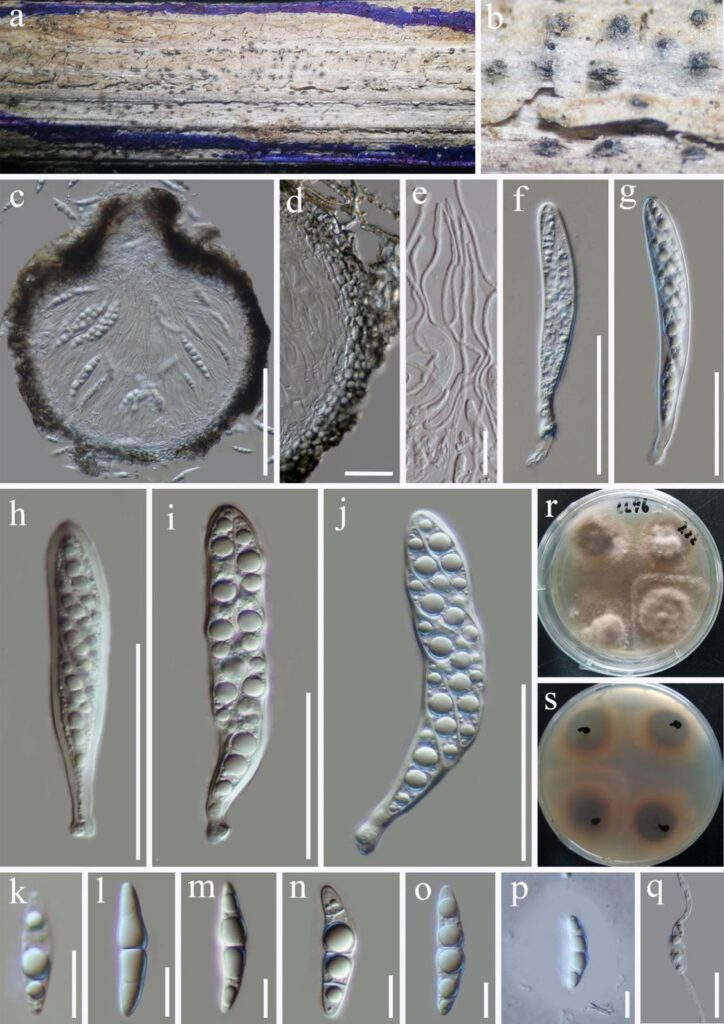Lentithecium yunnanensis W.H. L, Karunarathna & Tibpromma.2022 sp. nov.(Fig.2)
MycoBank number : MB 559622; Index Fungorum number: IF 559622; Facesoffungi number: FoF 10778;
Holotype: HKAS xxxxxx
Etymology: named after the place Yunnan where the new taxon was first discovered.
Saprobic on dead culms of Artemisia sp. in the marsh habitat. Ascomata (190–218μm diam, 222–236μm high) scattered to gregarious, semi–immersed to immersed beneath host epidermis, sometimes sparse erumpent, subglobose to globose in section, with a short papillate ostiolar neck (39.5–68μm long, 39–69μm diam), central, black, conspicuous. Peridium (17.5–29μm thick), multilayer layers, consist of dark–brown, thick–walled cells of textura angularis in the outermost layers, sometimes uniformly (23 μm thick, 4–6 layers), while (28μm thick at apex). Hamathecium (1.8–3.1 μm wide) tubular, hyaline, slenderly cylindrical, slightly septate, rarely anastomosing, unbranched, paraphyses. Asci 58.4–154×11–18 μm (x̅ = 82.0 × 14 μm, n = 25), fissitunicate, clavate, bitunicate, oblong to cylindrical, the apex is broadly round with visible apical chambers, 8–ascospored, short–stalked (9–29 μm long; x̅ = 15.06 μm, n = 22). Ascospores 21.5–40×11–18μm (x̅ = 29.7 × 7.5 μm, n = 30), hyaline, clavate to broadly fusiform with broadly rounded ends, slightly curved, two–celled, turning four–celled with age,1–3 septate, first septum is near the middle, and the second / thrid septum is 1/4, slightly constricted at the middle septum; widest at the centre, tapering towards ends, smooth–walled, surrounded by a hyaline, sheath (1–4 μm wide) in Black–Blue ink when fresh. Anamorph: undetermined.
Culture characteristics: ascospores germinated on PDA within 20h, pure mycelia were transferred to PDA and cultured for two weeks at 25°C, circular, effuse, irregular, surface rough, pale brown to brown, reverse dark brown. Mycelium superficial and partially immersed raised. Hyphae septate branched, hyaline, thin, smooth–walled.
Material examined: China, Yunnan, Kunming, Songhua Dam Reservoir, on dead culms of Artemisia sp., Wenhua Lu, 17 July 2021, (HKAS: XXXXX, holotype), ex–type living culture, KUMCC XXXXX.
Notes: Lentithecium yunnanensis was isolated on a dead culms of Artemisia sp. from Yunnan, China. Its morphology is comparable with the type species of the genus Lentithecium, L. fluviatile, and others taxa in Lentithecium in having immersed ascomata under a small blackened pseudoclypeus, subglbose–cylindricalasci with a distinct pedicel and broadly fusoid, hyline ascospores with 1–3 septa. The phylogenetic analyses of a combined sequence data–set (LSU, SSU, ITS and tef1–α) positions our novel species, L. yunnanensis (KUMCC XXXX) with other remaining taxa in Lentithecium (Clade A) with strong statistical supports (90 % ML, MP and 1.00 PP, Fig. 1). The phylogeny shows L. yunnanensis is basal to Lentithecium species with close affinity to L. fluviatile (CBS 123090), L. pseudoclioninum, L. clioninum. Morphologically, L. fluviatile differs from L. yunnanensis by having comparatively small ascomata (180–200 × 180–210 μm), apex without obvious apical chamber whereas L. yunnanensis has larger ascomata (190–218 × 222–236 μm) with a shallow ocular chamber. Lentithecium. fluviatile also has a relatively smaller (69–82 × 18–23) asci compared with L. yunnanensis (58.4–154 × 11–18). In addition, L. clioninum differs from L. yunnanensis by having a relatively larger 210–280 × 330–430) ascomata and (81.5–)86–118(–128)×15–19(–21) asci.

FIGURE 2. Lentithecium yunnanensis (HKAS xxxxx, holotype). a, b. Appearance of ascomata on host substrate. c. Section of ascoma. d. Peridium. e. Pseudoparaphyses. f–j. Asci. k–p. Ascospores. q. Germinating ascospore. r, s. Colony on PDA. Scale bars: c = 100 μm; f, g, h, i, j = 50 μm; d, q = 30μm; e = 20 μm; k, l, m, n, o, p = 10μm.
